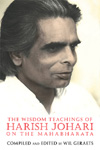Krishna is usually regarded as the eight incarnation of lord Vishnu and was born in the Dvarpara Yuga as the "dark one". Lord Krishna is the embodiment of love and divine joy, that destroys all pain and sin. He is the protector of sacred utterances and cows. Krishna is an instigator of all forms of knowledge and born to establish the religion of love.
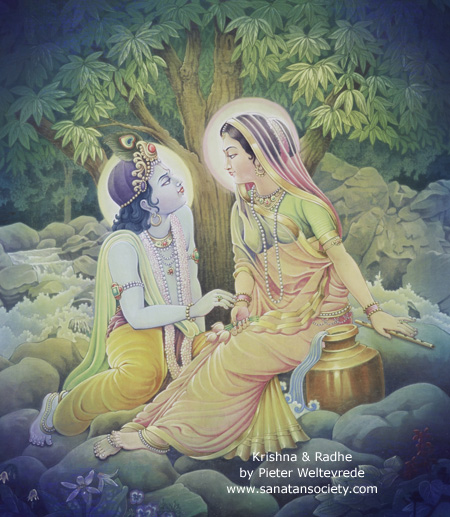 Krishna, Radha and Leela
Krishna, Radha and Leela
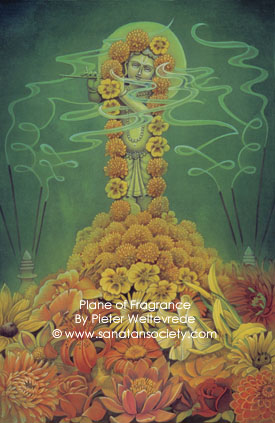 Bhakti Yoga is regarded as the most direct method to merge in cosmic consciousness. Food, sex, sleep, attachments, responsibilities - all are no longer important in Bhakti Yoga : only worship is. Paintings and sculptures of deities are an essential part of the Hindu worship known as Puja. In temples or home shrines, one finds images of many gods and goddesses that are worshipped on a daily basis, decorated with flowers and offered food and incense, such as this Krishna statue.
Bhakti Yoga is regarded as the most direct method to merge in cosmic consciousness. Food, sex, sleep, attachments, responsibilities - all are no longer important in Bhakti Yoga : only worship is. Paintings and sculptures of deities are an essential part of the Hindu worship known as Puja. In temples or home shrines, one finds images of many gods and goddesses that are worshipped on a daily basis, decorated with flowers and offered food and incense, such as this Krishna statue.  All Tantric and spiritual worship in the Hindu tradition begins with the invocation of Lord Ganesha (or Lord Ganesh), the elephant-headed god.
All Tantric and spiritual worship in the Hindu tradition begins with the invocation of Lord Ganesha (or Lord Ganesh), the elephant-headed god.
Little Krishna
Krishna was born as the 8th child of Devaki, sister of the cruel demon king Kamsa. The sage Narada had predicted that Kamsa would be killed by his nephew, so the king killed Devaki´s first six children. The 7th, Balarama escaped and the 8th, Krishna, was secretly exchanged for a cowherds daughter.
The demon king Kansa send many demons to kill Krishna, but all were defeated. Among them were the whrilwind demon Trinavata, Vatasura disguised as a calf, the enormous crane Bakasura, Aghasura the demon snake and the monstrous horse Keshisura. Lord Krishna also mastered the five-headed demon snake Kaliya, to stop it from poisoning the holy river Yamuna and send it back to the ocean. He jumped on the snake from a big Kadamba tree and then defeated him by dancing on his heads.
Krishna was brought up in a cowherds family and loved to play the flute to entertain the other cowherds, the milkmaids, and the cows. As a child, Krishna had great love for his foster-mother Yashoda and their relationship stands as a great exemple for the love between a mother and her child. Krishna also became very famous for teasing the milkmaids of Vrindavan as well as Yashoda. He and his friends would steal milk and butter, let the cows go free at milking time, hide the clothes of bathing girls or even break the water pots the milkmaids were carrying on their heads. Little Krishna was not just teasing purely for the fun of it. He wanted to destroy the ignorance of his devotees, teaching them not to be attached to matter and forms and only focus on him. As such, Lord Krishna is the deity of Hasya or Humour and a messenger of peace.
 Krishna, Radha and Leela
Krishna, Radha and Leela Radha and Krishna are the divine couple that rules love, romance and the aesthetic sense. Radha was foremost among the milkmaids of Vrindavan, as the incarnation of Lakshmi, Vishnu's spouse and Krishna's obvious favorite.
Love and devotion may also find beautiful expression in the relationship between lovers. In India, women often see their husbands as Krishna, while men see their wives as Radha, the beloved. When men become gods and women goddesses, then we do not see the imperfections, and see only perfection, divinity. Surrender and serving each other are the keys to any good relationship, which becomes a rehearsal of surrender to the universe and the divine.
While Krishna's love was truly universal, Radha sometimes expressed feelings of jealousy. Like it is shown in the painting here, one day Radha became jealous of Lord Krishna' flute, because it was allowed to touch his lips and because he would breath his prana into it. Thus she took it from Krishna and then did not want to return it. Some thus see the relationship between Krishna and Radha as the love between god and man, between self and ego.
One moonlit night, Krishna multiplied his body into many to dance with all the milkmaids and fulfill their desire for union with him. The love between Krishna and the milkmaids represents the divine play (Leela) between reality (consciousness) and illusion (form), purusha (soul) and prakriti (primordial nature), divinity and humanity. The maidens dance around Krishna as electrons dance around the nucleus of every atom, and as body molecules and energies dance around the soul of every being.
Lord Krishna was only eight years old when he left Vrindavan and and his beloved Radha to study in the ashram of the saint Sandeepani. Therefore, everything that happened between Krishna and Radha or Krishna and the milkmaids took place when they were children. They were all very conscious of being incarnations of divine beings and saints. Whatever happened between them can only have been very romantic and spiritual. A lot of it was child-play.
Krishna and Bhakti in the Mahabharata
After Krishna killed Kansa, he became king. In the great Mahabharata epic, Krishna spoke memorable words on the essence of Bhakti Yoga or the yoga of pure spiritual devotion. During the battle of Kurukshetra, Lord Krishna revealed to Arjuna the essence of Bhakti Yoga, of love for God which is love. This revelation is found in the famous Hindu scripture called the Bhagavad Gita. The Deity is the beloved and the devotee is the lover. When the Bhakta is blessed by divine grace he feels undivided union and non-dual consciousness.
 Bhakti Yoga is regarded as the most direct method to merge in cosmic consciousness. Food, sex, sleep, attachments, responsibilities - all are no longer important in Bhakti Yoga : only worship is. Paintings and sculptures of deities are an essential part of the Hindu worship known as Puja. In temples or home shrines, one finds images of many gods and goddesses that are worshipped on a daily basis, decorated with flowers and offered food and incense, such as this Krishna statue.
Bhakti Yoga is regarded as the most direct method to merge in cosmic consciousness. Food, sex, sleep, attachments, responsibilities - all are no longer important in Bhakti Yoga : only worship is. Paintings and sculptures of deities are an essential part of the Hindu worship known as Puja. In temples or home shrines, one finds images of many gods and goddesses that are worshipped on a daily basis, decorated with flowers and offered food and incense, such as this Krishna statue. See also "Little Krishna" and Krishna Pictures.
Click to hear the Krishna mantra online.
 All Tantric and spiritual worship in the Hindu tradition begins with the invocation of Lord Ganesha (or Lord Ganesh), the elephant-headed god.
All Tantric and spiritual worship in the Hindu tradition begins with the invocation of Lord Ganesha (or Lord Ganesh), the elephant-headed god. Ganesha became the Lord (Isha) of all existing beings (Gana) after winning a contest from his brother Kartikay. When given the task to race around the universe, Ganesha did not start the race like Kartikay did, but simply walked around Shiva and Parvati, both his father and mother as the source of all existence (more about this story here).
Attributes of Ganesha
Many stories describe how Ganesha (Ganesh) got the elepant head. One tells how Parvati created Ganesha in absence of Shiva to guard her quarters. When Shiva wanted to see her Ganesha forbid it, at which point Shiva cut of his head. Later Shiva restored Ganesha to life and provided him with the head of an elephant, because no other was available. In another story, Ganesha's head is burned to ashes when Saturn is forced by Parvati to look at her child and bless him. The human part of Ganesha represents that which is manifested, while the elephant part represents the unmanifested great being. Therefore the elephant part is the head.
Ganesha (Ganesh) rides a rat that represents the subjugated demon of vanity and impertinence. The conch represents the sound that creates Akash. The laddu (sweet) represents Sattva. The snakes represent control over the poisons of the passions and refer to Shiva, father of Ganesha. The hatchet cuts away the bondage of desires. The mudra grants fearlessness. The broken tusk is the one with which Ganesha wrote the Mahabaratha.
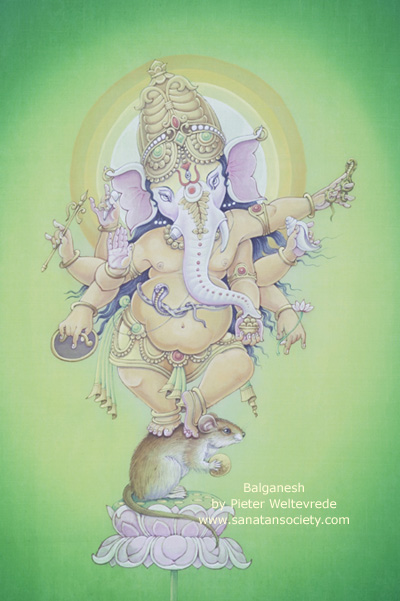 Some say that Ganesha has so much devotion to his mother Parvati, that he remains celibate. When he understood that all women are but manifestations of his mother, he decided not to marry. Others hold however that Ganesha is the consort of Buddhi and Siddhi, daughters of Brahma. 'Ga' symbolizes Buddhi (intellect) and 'Na' symbolizes Vidnyana (wisdom). Ganesha is thus considered the master of intellect and wisdom. Ganesha is also often portrayed along with Saraswati and Lakshmi, symbolising that success and beauty always accompany wisdom.
Some say that Ganesha has so much devotion to his mother Parvati, that he remains celibate. When he understood that all women are but manifestations of his mother, he decided not to marry. Others hold however that Ganesha is the consort of Buddhi and Siddhi, daughters of Brahma. 'Ga' symbolizes Buddhi (intellect) and 'Na' symbolizes Vidnyana (wisdom). Ganesha is thus considered the master of intellect and wisdom. Ganesha is also often portrayed along with Saraswati and Lakshmi, symbolising that success and beauty always accompany wisdom. Acceptance of the somewhat funny looking elephant-headed man as the divine force stills the rational mind and its doubts, forcing one to look beyond outer appearances. Thus Ganesha creates the faith to remove all obstacles, forcing one to look beyond form, removing doubts and pointing out the spiritual side of everything. Ganesha is thus often worshipped to remove obstacles.
Forms of Ganesha
Traditionally, Ganesha comes in 32 different forms. One for example is Heramba Vinayakar, the Pancha Muga Ganesha or five-faced Ganesha. This form is specifically known as the protector of the weak. This ten-armed Ganesha is seated on a lion instead of the usual rat. He extends the gestures of protection and blessing while holding a noose, prayer (japa) beads, axe, hammer, tusk, garland, fruit and modaka. Pancha Ganapati is a popular festival to the five-faced elephant God. It consists of five days of gift-giving and festivities within the home, especially for the children.
Another famous form is Balganesh, the child version of this famous deity.
Ganesha Yantra
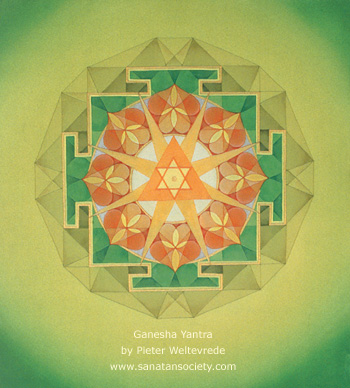 The Ganesha Yantra creates internal balance. The bhupur (eight-dimensional square) is in viridian green, a very balancing color. Meditation on this color produces red, bringing inspiration to the sadhaka. The eight-petaled lotus is the octave of prakriti : the 5 elements plus the 3 gunas. The sixpointed star brings balance between male and female energies. It is placed upon an upward pointing triangle that represents the amrit. The point (bindu) in the middle is Ganesha. It is the main object of the meditation : everything around it points towards it. It must be made of a radiant golden color. Read more about yantras.
The Ganesha Yantra creates internal balance. The bhupur (eight-dimensional square) is in viridian green, a very balancing color. Meditation on this color produces red, bringing inspiration to the sadhaka. The eight-petaled lotus is the octave of prakriti : the 5 elements plus the 3 gunas. The sixpointed star brings balance between male and female energies. It is placed upon an upward pointing triangle that represents the amrit. The point (bindu) in the middle is Ganesha. It is the main object of the meditation : everything around it points towards it. It must be made of a radiant golden color. Read more about yantras. Beyond the Trinity
The One is beyond trinity and duality. Hence it is without form, so it cannot be named nor painted. For some the One will quite simply be named Shiva, or Krishna, or Devi. Still in Hinduism we find certain deities that through their very form try to come closer to the big IT. They mostly show the union of opposing forces, such as those of creation, preservation and destruction or of the male and female energies. Or they may be shown as particularly neutral, such as Ganesha.
Even though Ganesha is the son of Shiva, he is thus regarded as a being beyond the trinity, as Ganapati, the lord of all categories or ganas, trinities included. The Upanishads even say, "You alone are the creator, the sustainer and the destroyer". Ganesha is worshipped by virtually every Hindu, whatever his other spiritual preferences.





S.KARTHIKEYAPRABU




















 India Vilas - The Comprehensive Info on Indian Temples, Gods & Goddess Pictures, Gods &Goddess Stories etc.
India Vilas - The Comprehensive Info on Indian Temples, Gods & Goddess Pictures, Gods &Goddess Stories etc.Hindu Gods : Ganesha (Ganesh)- description of this messenger of spirituality ... man Ganesha as the divine force stills the rational mind and it's doubts, ...
Picture Of The Day : Hindu God Lord Ganesh ... Telugu Movie Stills · South Indian MoviesStills .... Gods & Goddess Pictures. Spiritual Wallpapers ...
Buy God Still Speaks in India. Price:Rs.774 Discount:18% + Free Shipping on 1602665923God Still Speaks. Book Review of God Still Speaks by Monica M ...


.jpg)








.jpg)






